Reports
Gchine Coverup: Part 2
by David Albright and Sarah Burkhard
February 20, 2020
Published February 20, 2020; Revised February 24, 2020 to correct annotation of Figure 4
The Iranian regime shot down a Ukrainian passenger airplane, attempted to cover it up, denying access to foreign officials, destroying evidence at the crash site, ultimately admitting the truth only following intense international and domestic pressure. The recent coverup is reminiscent of Iran’s deception about its past and possibly on-going nuclear weapons program, a program Iran vehemently denies ever having had, despite overwhelming evidence to the contrary. Even with years of effort, the international community has not so far found a way to convince Iran to admit the obvious about its nuclear weapons efforts, some of which may continue today. Faced with Iran’s full-throated denials, the Institute has sought to see behind its deceptions, based on documents in the Iran Nuclear Archive, seized by Israel in 2018, subsequently shared with the international community, and made available for independent translation and analysis. The Iranians themselves created these secret documents, providing a firsthand look into Iran’s coverup of its nuclear weapons activities.
The Institute recently obtained a document that sheds further light on Iran’s deception to the International Atomic Energy Agency (IAEA) about its past nuclear weapons activities. This Farsi-language document, independently translated and assessed by the Institute, apparently shows an Iranian effort to falsify a document in support of its misleading declaration to the IAEA. In this case, Iran has falsely declared to the IAEA about the Gchine mine and uranium ore concentration (UOC) plant, stating inaccurately Gchine was never part of a nuclear weapons program and the Iranian company Kimia Maadan, building the plant, never had a connection to that program. To that end, Iran apparently falsified corporate dates of dissolution of Kimia Maadan in official Iranian records to support its deception. The Iranian document includes an official typed, signed, and stamped company dissolution record, which has handwritten alterations, mostly dates, written across it. Handwritten dates match exactly with the dates Iran included in its fallacious declaration to the IAEA.
Having available two alternative dissolution records, one of which is typed, while the other matches the story told to the IAEA, inevitably leads to the question of which narrative is true and which one is false. Our findings conclude that the company dissolution as given by the typed dates in the document is more likely to be true, or at least closer to the truth than the handwritten alterations. Connecting this new document to an earlier Institute report on Gchine unveils Iran’s motive for falsifying the record. Further analysis was conducted using both the typed and the handwritten dates to test the strength of each narrative, and it supports our conclusion. This further analysis includes results from searching company records available online, an analysis of the pattern of the alterations of dates and the resulting timelines of events, and a comparison of the company record with other companies’ records published in the same timeframes. A key finding is that the altering of the dates, e.g. using the handwritten dates, leads to inconsistencies within official Iranian records.
Introduction
The newly acquired document is from the Iranian Nuclear Archive, a collection of documents, images, and computer files seized by Israel in Tehran, centering on Iran’s nuclear weapons efforts in the period of 1999-2004, with plans for a downsized nuclear weapons program afterwards.1 Documents in this immense collection continue to be translated and assessed in Israel and around the world, producing almost daily surprising revelations and additional insights about Iran’s nuclear weapons program in the early 2000s, its efforts to hide it, and its continuation in a reduced but more secret form.
An earlier Institute study, based on other documents in the archive, showed that the Iranian leadership decided in 2003 to deceive the IAEA about the Gchine (also spelled Gachin) facility, located in southern Iran near Bandar Abbas, and alternatively called the Bandar or Bandar Abbas Project, by preparing a false narrative about the Gchine facility always being a civilian nuclear facility.2 In fact, it had been built as part of the military-controlled Amad Plan, a program to build five missile-deliverable nuclear weapons (see Figure 1).3
The product of Gchine was uranium ore concentrate, better known as “yellowcake,” the key nuclear source material for Iran’s planned production of highly enriched uranium (HEU) for nuclear weapons. Figure 2 is an Institute-annotated ground photo of the Gchine UOC that was discovered in the Nuclear Archive. The “other-worldly” terrain in the photo is real, and is due to the unusual salt dome/plug geology of the site.
The new document allows a deeper understanding of how Iran carried out its deception to the IAEA about this site. Importantly, falsified documents allowed Iran to bolster its misleading statements, convincing many, including at the IAEA, that it was telling the truth.
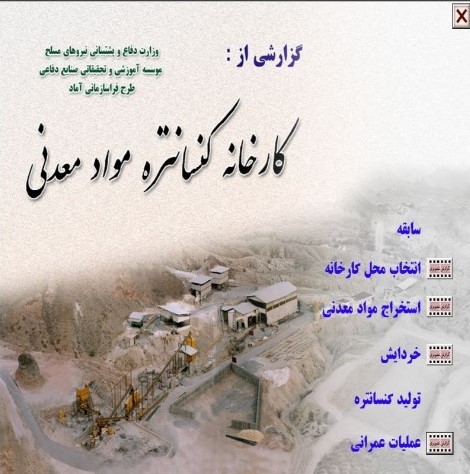

Figure 1. Title page of Iranian presentation on Gchine in Farsi (left) and translation by professional translation service (right) shows an image of the Gchine site on the cover of a report prepared under the Amad Supraorganizational Plan of Ministry of Defense and Armed Forces Logistics’ Institute for Training and Research of Defense Industries. This institute is also known as the Defense Industries Training and Research Institute or Training and Research Institute of Defense Industries.
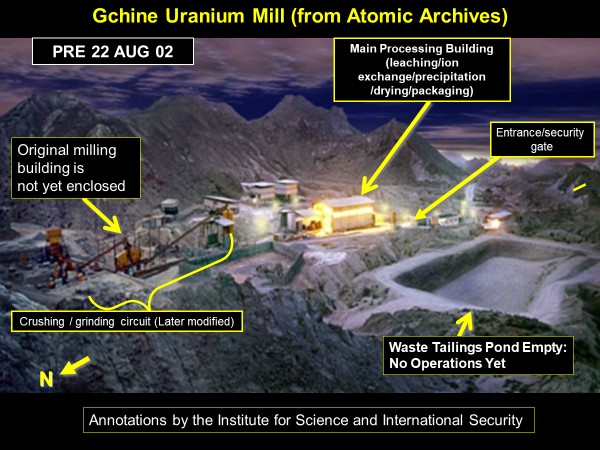
Figure 2. The Gchine yellowcake production plant, or mill, as seen in a photo discovered in the Iran Nuclear Archive (sometimes called the Atomic Archive.)
The Motive: Creating a False Narrative on Gchine
Iran’s cover up of Gchine was part of a broader effort to hide the existence of a large-scale nuclear weapons effort, while preserving Gchine for on-going use as part of a declared, e.g. “civilian” nuclear program under the control of Iran’s Atomic Energy Organization of Iran (AEOI). As mentioned above, this narrative required two false statements to the IAEA: 1) Gchine was always a peaceful nuclear facility, under the ownership and authority of the AEOI, and 2) it was never under military control or for use to make uranium for nuclear weapons. Using documents from the archive, the earlier Institute report disproved both claims.4
This earlier Institute report includes a key archive document, a translated record of decisions reached by a senior group of Iranians after an act of the Supreme National Security Council of Iran, with the approval of the head of the AEOI, that discusses the transfer of Gchine from the military program to the AEOI, called “evolution and delivery.”5 This decision document states that the “process of delivering the above-mentioned project to the Iranian Atomic Energy Organization started on March 18, 2003.”6 This date is soon after the start of a round of controversial inspections of Iran’s previously undeclared uranium enrichment program that ultimately showed that Iran had violated its safeguards agreement and, by extension, the Nuclear Non-Proliferation Treaty. The document continues, “the Iranian Atomic Energy Organization would declare the above-mentioned project to the International Atomic Energy Agency as the uranium mine and uranium concentration plant under the supervision of the atomic energy organization.”7
Another part of the cover up was not treated in the earlier Institute report, namely Iran claiming the Iranian company Kimia Maadan contracted with the AEOI to build the plant. The recently obtained document appears to shed light on this aspect of the subterfuge, summarized in a February 22, 2008 IAEA safeguards report on Iran, covering a period of time when the IAEA was focusing on resolving a series of discrepancies about Iran’s declarations about Gchine and other nuclear activities and facilities.8 According to this IAEA summary, Iran declared that the AEOI’s Ore Processing Center (OPC) conducted the preparatory work for building the Gchine mine and mill, the project receiving approval on August 25, 1999, under the 1999-2003 five-year plan.
To build Gchine, according to Iran’s official declaration, the AEOI contracted with the company Kimia Maadan (KM), a new company which drew core staff from the AEOI’s Ore Processing Center at the Tehran Nuclear Research Center. Iran provided the IAEA supporting documentation that KM was registered as a company on May 4, 2000.
Further, according to the 2008 summary of Iran’s declaration to the IAEA:9
Iran stated that KM [Kimia Maadan] had had only one project — the one with the AEOI for construction of the Gchine UOC plant on a turnkey basis. According to Iran, because of KM’s financial problems, the company ceased work on the Gchine project in June 2003, when the three-year contract with the AEOI came to an end. Iran stated that KM was officially deregistered on 8 June 2003 and provided a document supporting this statement. After KM stopped work, the OPC again took over work on the Gchine UOC plant.
A key part of Iran’s narrative is that Kimia Maadan existed until 2003, the end of the purported AEOI five-year plan. The new document from the archives obtained by the Institute shows that this narrative appears false; it shows that Kimia Maadan Natanz, likely the same company in Iran’s declaration, had been dissolved 18 months earlier (see Figure 3 and English translation below). According to the document, Kimia Maadan Natanz was “announced dissolved” on December 22, 2001, and the announcement of dissolution, or deregistration, by the Iranian Document and Property Registration organization occurred on February 7, 2002, not on June 8, 2003 as Iran told the IAEA. Moreover, this document appears to contain markings, serving as instructions to an unidentified person where modifications are needed, as part of producing a new document with altered dissolution dates, in particular a modified deregistration date of June 8, 2003, an exact match to the date given by Iranian officials to the IAEA.
The official dissolution document lists Mahmoud Haratian Nezhadi as the settlement director, with a settlement address given as Tehran, Vanak, Molla Sadra Street, South Shiraz Street, East Garmsar St, No. 13. This may have been the address of Kimia Maadan Natanz. Information provided to the IAEA states that the head of Kimia Maadan, a Mr. Haratian, had close relations to the Physics Research Center, which was the military predecessor of the Amad program. Likely, the information describes the same person, providing another link between Kimia Maadan Natanz, Kimia Maadan more generally, and the military nuclear program.
Although it could not be determined when the document was altered, it may be part of a set of alterations to the original leading to the falsified document given by Iran to the IAEA and mentioned in the IAEA summary above.
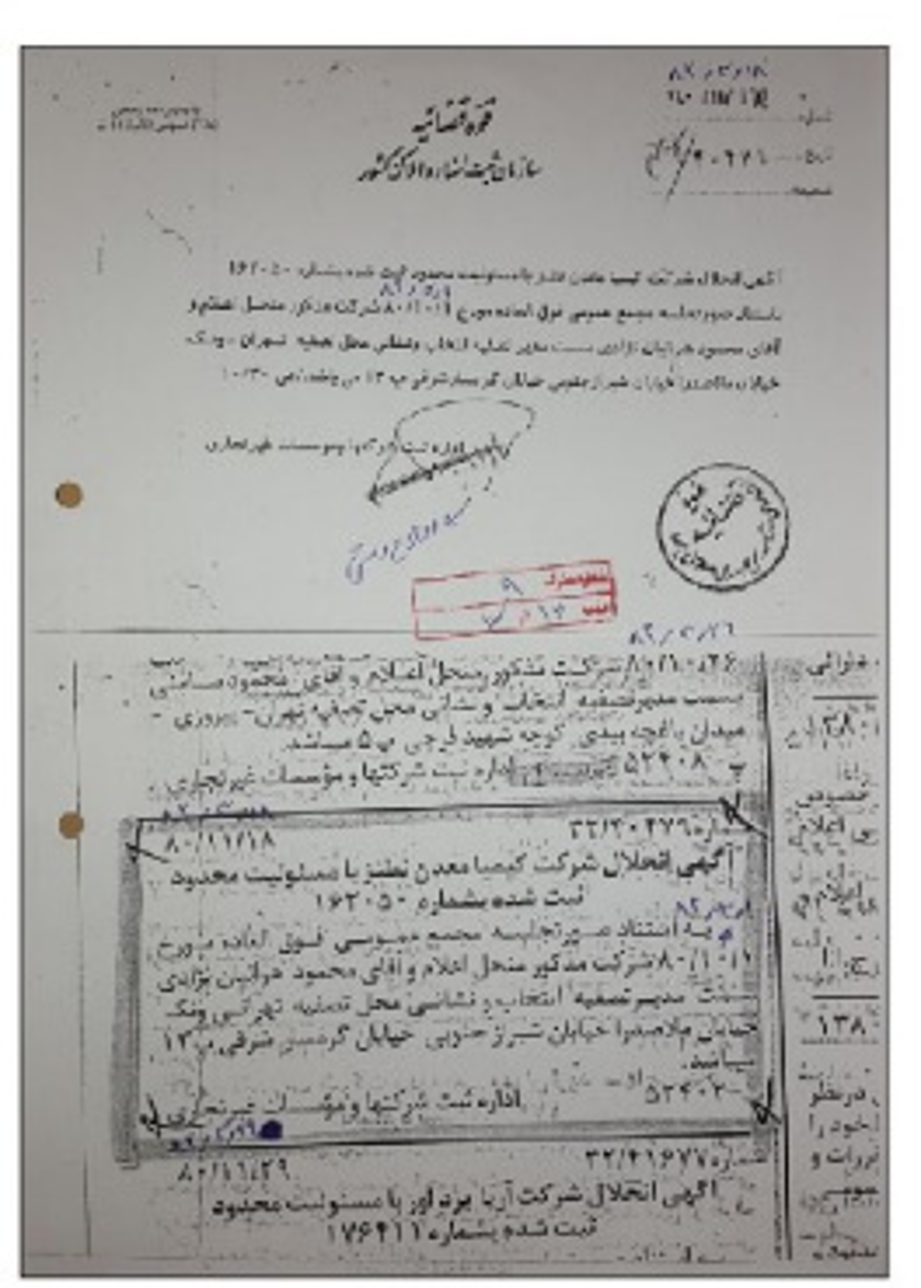
Figure 3. Farsi-language document from the Nuclear Archive showing dissolution of Kimia Maadan Natanz and alterations in the dates.
The one-page document is in two parts (see Figure 3 and accompanying translation on the following two pages). The top part is an announcement of dissolution, or deregistration, of Kimia Maadan Natanz Limited Liability Company by the Document and Property Registration Organization of the Islamic Republic of Iran, Judicial System of Iran. The date of the document is given as February 7, 2002. The document states, “Based on the minutes of the extraordinary General Assembly dated December 22, 2001, the said company was announced dissolved.” This sentence may refer to an action of the board or shareholders of Kimia Maadan Natanz to dissolve the company. Above the typed date of December 22, 2001 date is handwritten in blue ink a new date of May 22, 2003. Above the typed date of February 7, 2002 date is handwritten in blue ink a date of June 8, 2003.
The bottom part of the document contains three newspaper announcements, undated, with the one for Kimia Maadan Natanz in the middle. (The part referring to Kimia Maadan is encircled and marked with X’s (Figure 3).) This portion of the document appears to have been cut from a national newspaper and placed below the memo and photocopied together, perhaps intended to create false authenticity. Under Iranian government regulations, all company registrations and dissolutions need to be published in certain national newspapers, and this section seems to be a copy of such a newspaper. This segment contains three different announcements that seem to belong to three different companies that likely dissolved back to back around the same timeframe. On the right side of these three announcements is illegible text about some other companies. The text is incomplete, but in two instances the year 1380 is mentioned, which is a match with the dates of the three dissolution announcements. Just like in the official dissolution announcement for KM Natanz, handwritten in blue above the February 7, 2002 date is the date June 8, 2003. Handwritten above the December 22, 2001 date is May 22, 2003.
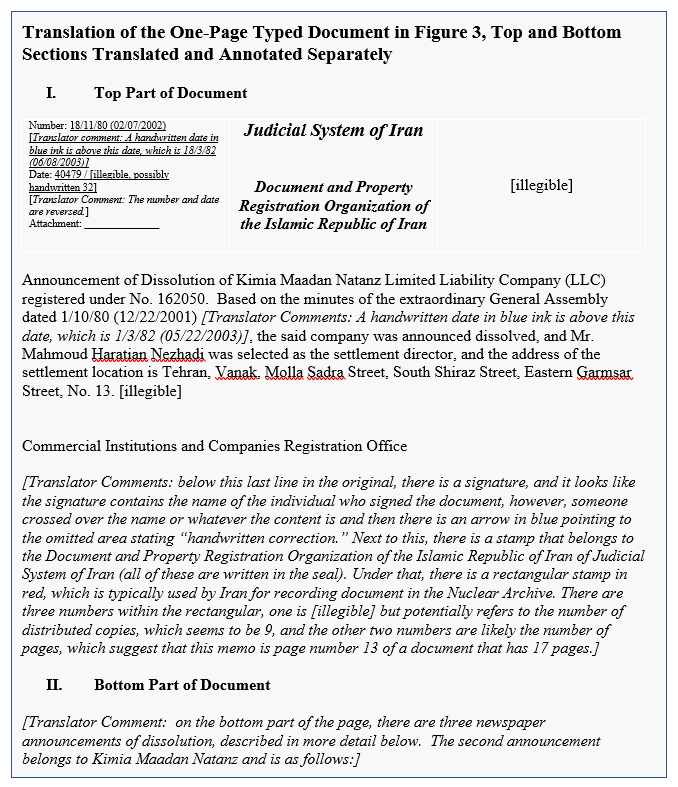
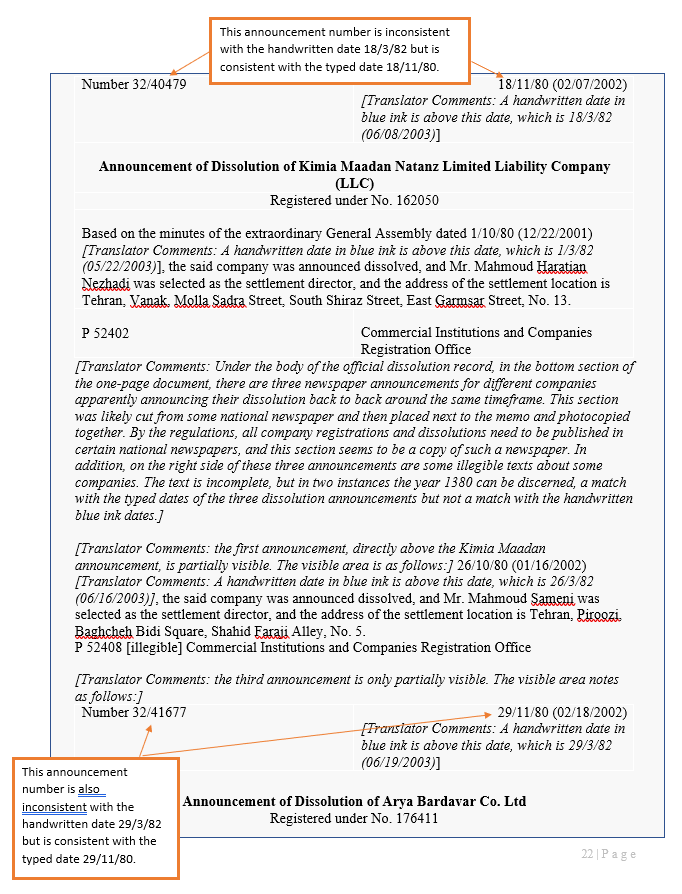
There is a visible pattern in the date changes. In the Farsi dates, the writer kept the “days” the same but changed all “months”, whether they were “10” or “11”, to “3” and changed the “years” by two years from “80” to “82”. The Annex discusses the implications of these changes.
Several questions arise from this particular choice of date alterations, as developed in the Annex. Why was an effort made to alter the dates for the other companies mentioned in the newspaper announcements as well, only partially at that, if Kimia Maadan was the only company of interest to the IAEA? Was the document altered further? We have not seen the document that the IAEA received. Did it include the altered bottom part, with only partial text for these two other companies, perhaps to create false authenticity of the source document? Could the potentially unintentional change in sequence of events aid in disproving Iranian information submitted to the IAEA?
An effort was made to find records of Kimia Maadan Natanz on official Iranian government websites. However, it did not show up in several searches of the Legal Announcement Database on the website of the Official Newspaper of the Islamic Republic of Iran (http://www.rrk.ir/News/NewsList.aspx.) According to the website, the database was created in 2015, when the Legal Announcement Database Integration Project transferred all legal announcements from the year 1382 (03/21/2003 - 03/19/2004) to 1391 (03/20/2012 - 03/19/2013) from the www.gazette.ir website to this website. A typical legal announcement record on any decision regarding any company includes the name of the company, the registration number, a tracking number, the date of the legal announcement, the number of the legal announcement, the date of the public announcement in the newspaper, and the number of the newspaper. 10 Given that Iran reported to the IAEA that Kimia Maadan was deregistered in June 2003, the announcement should be part of this database. Unless, of course, the announcement is actually from February 2002 as shown in the typed documents.
No results were returned for searching the announcements made prior to 1396 (03/21/2017) for a variety of search combinations related to Kimia Maadan. Examples include searches conducted using Kimia Maadan Industrial Group, Kimia Maadan Natanz, Registration Number 162050, and Kimia Maadan Natanz in combination with its Registration Number 162050. No relevant result was returned when searching for Kimia Maadan only (there are several companies that include the words Kimia and Maadan, but none appeared relevant.) 11
However, when searching for the typed date 18/11/80, announcements for other companies appeared and the announcement numbers had a striking similarity with the announcement number for Kimia Maadan. In fact, an announcement with number 32/40478, exactly one less than the announcement number for Kimia Maadan (32/40479) was made on 18/11/80 (see Figure 4). Other numbers from that day included 32/40456 and 32/40496 (see Figure 5), which appears a reasonable range of announcements made on one day. In line with this trend, an announcement number from a few days later for Arya Bardavar could reasonably be 32/41677, as found on the typed document, 11 days and about 1200 announcements later. The dissolution announcement for Arya Bardavar could not be found in the online database either, despite using multiple searches and search terms.
The Institute attempted to conduct further searches to show the announcement numbers of Kimia Maadan and Arya Bardavar, 32/40479 and 32/41677, respectively, not only fit into a pattern of announcement numbers from February 2002 (11/80), but do not appear to fit a pattern of announcement numbers from June 2003 (3/82). Two announcements made on June 8, 2003 (18/3/82) have the announcement numbers 32/9117 and 32/9148, which is very different from 32/40479, even if it indicates that the numbering system restarts periodically. If the numbering system restarts once a year, it is logical that numbers at the beginning of the Iranian year (month 3 corresponds to June) would be expected to be relatively small, while numbers at the end of the Iranian year (month 11 corresponds to February) would be expected to be much larger. Similarly, two announcement numbers from June 19, 2003 (29/3/1382), the handwritten date of the announcement of dissolution of Arya Bardavar, are 32/11077 and 32/11024. These numbers are much smaller than Arya Bardavar’s announcement number 32/41677.
This analysis shows that the announcement numbers typed on the document seem not to have been altered, indicating that the documents were more likely to have been issued on the typed date (end of an Iranian calendar year) than on the handwritten date (beginning of the Iranian calendar year). Moreover, this analysis supports that the handwritten dates are inconsistent with the announcement numbering system.
Another search was conducted for Kimia Maadan Natanz’ dissolution date on the web site of the Document and Property Registration Organization of the Islamic Republic of Iran. A record was found, with the same registration number and address, stating that the company was dissolved but without any date of dissolution. It did contain the date of the registration of the company, May 2, 2000.
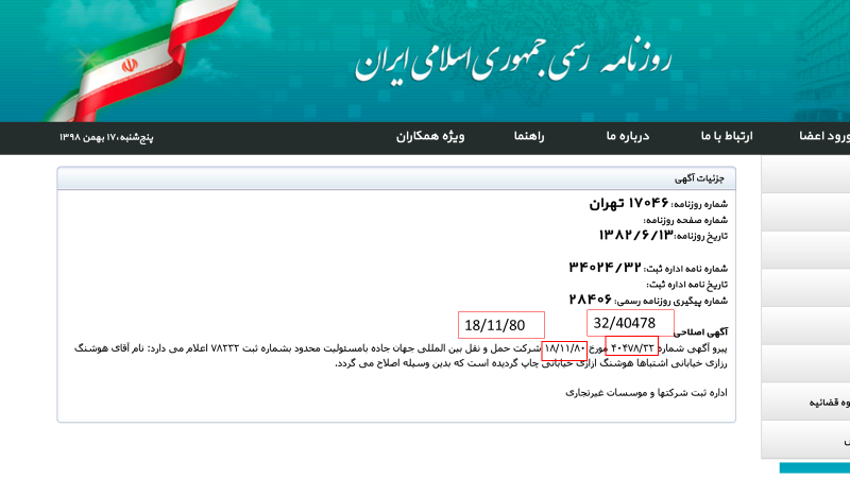
Figure 4. An announcement regarding an unknown company in the Legal Announcement Database, made on 18/11/80 (02/07/2002), with an announcement number one less than that for Kimia Maadan.

Figure 5. Two search results from the Legal Announcement Database showing two further announcement numbers from unknown companies from 18/11/80 (02/07/2002) with similarity to the announcement number from Kimia Maadan. The search results were translated by Google Translate, which added the /32 at the end of the number rather than as 32/ at the beginning.
Further Questions about Kimia Maadan and Gchine
The five-year plan declared by Iran to the IAEA is likely that created by the Iranian nuclear weapons program, where Iran falsely ascribed it to the AEOI. The nuclear weapons program had various multi-year plans for its projects. A table from the Nuclear Archive, written in about 2002, discussing the various Amad plan projects, lists the start date for a project involving yellowcake production as June 1, 1999, close to the August 1999 date declared by the AEOI as the start of construction of Gchine. Information in the Kimia Maadan dissolution document, namely the registration number, allows the discovery of additional information about Kimia Maadan Natanz, independent of Iran’s declaration to the IAEA. This information gives a date of May 2, 2000 for the formation of Kimia Maadan Natanz, slightly different than the May 4 date given by Iran to the IAEA, but consistent with the start of the Amad project to make yellowcake. A lengthy search did not reveal any public documentation on its dissolution date.
This archive table lists the completion date of yellowcake production, the output of Gchine, as October 6, 2001. This is a few months before the dissolution of Kimia Maadan Natanz, again consistent with Kimia Maadan being the contractor responsible to build Gchine. Nonetheless, the exact role of Kimia Maadan requires further clarification, at Gchine and in other Amad fuel cycle facilities, including uranium tetrafluoride and uranium hexafluoride production.
The archive materials show that Iran transferred control of the Gchine mine and uranium concentration plant to the Atomic Energy Organization of Iran (AEOI) from the Amad program, providing a civilian cover over the facility, defusing international pressure, helping avoid an admission of its secret nuclear weapons program. A benefit was to keep a significant military fuel cycle activity intact. At the time, Iran had no other domestic uranium mine close to being operational. Iran’s consistent deception and denials to the IAEA contributed to its success in keeping operational, during a period of intense international pressure, this critical element of its emerging nuclear fuel cycle and residual nuclear weapons capability. **Annex: Analysis of the Alterations of the Dates **
There is a visible pattern in the date changes. In the Farsi dates, the writer kept the “days” the same but changed all “months”, whether they were “10” or “11”, to “3” and changed the “years” by two years from “80” to “82”.
Figure A.1 shows the chronology of events using the Farsi dates translated into English and converted to the Gregorian calendar. The top graph shows the actual timeline derived from the typed dates, and the bottom one shows the altered timeline based on the blue handwritten dates. The sequence of events changed from their alteration of dates because the writers consistently changed the month to “3” in Farsi, instead of being consistent with how much time they added. They effectively added a year and five months (516 days) to the first two dissolution events (Kimia Maadan and the unknown company, labeled “Company 2” here) and a year and four months (486 days) to the other two events (public notice of the dissolution of Kimia Maadan and Arya Bardavar, labeled “Company 3” here.)). This variation puts the public notice of the dissolution of KM, which happened on the 8th of the month, before Company 2 was announced dissolved, which occurred on the 16th of the month. Moreover, it puts the Company 2 dissolution and Company 3 announcement of dissolution within a matter of days instead of within one month.
Several questions arise from this. Why was an effort made to alter the dates for Companies 2 and 3 as well, only partially at that, if Kimia Maadan was the only company of interest to the IAEA? Was the document altered further? We have not seen the document that the IAEA received. Did it include the altered bottom part, with only partial text for Companies 2 and 3 as shown, perhaps to create false authenticity of the source document? Why were all altered dates put into one month instead of preserving the spread of the original timeline? Could the potentially unintentional change in sequence of events aid in disproving Iranian information submitted to the IAEA?

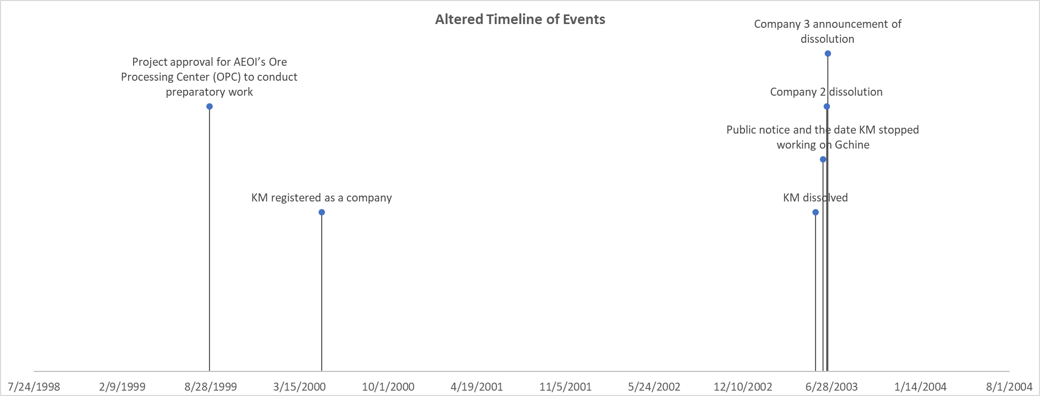
Figure A.1. The chronology of Farsi dates in the document (see Figure 3) translated into English. The top graph shows sequence of events based on the actual dates, and the bottom one shows the altered dates and events. In this figure, the term “company dissolved” represents the initial date of announced dissolution, likely announced by the company itself, and the “announcement of dissolution” is the date when the official Iranian government entity dissolved or deregistered the company.
1. David Albright, Olli Heinonen, and Andrea Stricker, “Breaking Up and Reorienting Iran’s Nuclear Weapons Program - Iran’s Nuclear Archive Shows the 2003 Restructuring of its Nuclear Weapons Program, then called the AMAD Program, into Covert and Overt Parts,” Institute for Science and International Security, October 29, 2018, http://isis-online.org/isis-reports/detail/breaking-up-and-reorienting-irans-nuclear-weapons-program; David Albright, Olli Heinonen, and Andrea Stricker, “The Plan: Iran’s Nuclear Archive Shows it Planned to Build Five Nuclear Weapons by mid-2003,” Institute for Science and International Security, November 20, 2018, http://isis-online.org/isis-reports/detail/the-plan-irans-nuclear-archive-shows-it-originally-planned-to-build-five-nu ↩
2. David Albright, Olli Heinonen, Frank Pabian, and Andrea Stricker, “Anatomy of Iran’s Deception and How Iran Benefited,” Institute for Science and International Security, December 19, 2018, https://isis-online.org/isis-reports/detail/anatomy-of-irans-deception-and-how-iran-benefited-irans-nuclear-archive-con/8 ↩
3. “The Plan: Iran’s Nuclear Archive Shows it Planned to Build Five Nuclear Weapons by mid-2003.” Amad is a transliteration of a Persian word meaning logistics. Despite being capitalized in the documents in Figure 1, it does not appear to be an acronym and is not capitalized by the Institute. ↩
4. “Anatomy of Iran’s Deception and How Iran Benefited.” ↩
5. “Anatomy of Iran’s Deception and How Iran Benefited.” Figure 9. ↩
6. Ibid. ↩
7. Ibid. ↩
8. IAEA Director General, Implementation of the NPT Safeguards Agreement in the Islamic Republic of Iran, GOV/2008/4, February 22, 2008. https://isis-online.org/uploads/isis-reports/documents/IAEA_Iran_Report_22Feb2008.pdf ↩
9. Ibid. ↩
10. In many records of legal announcements, it was noted that the newspaper announcement occurred much later, often years, after the official legal announcement. ↩
11. It should be noted that the search function appeared to have bugs in general and was not functioning properly, either by design or lack of coding ability, and the Institute used a combination of broad and specific search terms to take into consideration potential search function failures. Of note, for a few days in the midst of our searching, we were unable to get any results for any search, even empty ones, very broad ones, and ones that reported results earlier. ↩

 twitter
twitter